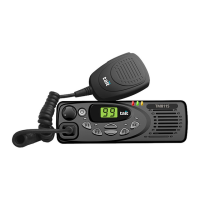TM8100/TM8200 Service Manual Frequency Synthesizer Fault Finding 235
© Tait Electronics Limited June 2006
Task 39 —
TP502 Test Point
(TP501 Grounded)
If the loop was oscillating, Task 38 will have revealed any fault in the
VCXO circuitry. If there was no fault, or if the circuit was repaired, a check
at the
TP502 test point is now required. This will show if there are any
additional faults in the mixer or LPF circuitry.
1. Use the oscilloscope probe to check the difference frequency at the
TP502 test point (see Figure 9.17). The signal is SYN CDC FCL and
should be:
2. If the signal is correct, go to Step 6. If it is not, go to Step 3.
3. The mixer circuitry (IC501 and associated components) or the LPF
circuitry (IC502 pins 5 to 7, and associated components) under the
FCL TOP can is faulty (see Figure 9.17). Locate the fault.
4. Repair the circuitry. Note that the TCXO input to the mixer
(see Figure 9.17) should be:
Also, the VCXO input to the mixer (see Figure 9.17), although
noisy and difficult to measure, should be:
5. Confirm the removal of the fault, and go to Step 6. If the repair
failed, resolder R527 in its original position as shown in Figure 9.17,
replace the board and go to “Final Tasks” on page 157.
TP502 test point: sine wave with frequency of at least 15kHz and
amplitude of 1.1 ± 0.2 V
pp
on 1.5 ± 0.1 V DC
A4 band: the frequency should be:
TP502 test point: triangular wave with frequency of at least 15kHz and
amplitude of 1.5 ± 0.2 V
pp
on 1.5 ± 0.1 V DC
TCXO input at R521 (pin 4 of IC501):
TCXO input: square wave with frequency of 13 MHz
and amplitude of 3.0 ± 0.2 V
pp
A4 band: TCXO input at R520 (pin 4 of IC506):
TCXO input: square wave with frequency of 10.4MHz
and amplitude of 3.0 ± 0.2 V
pp
VCXO input at R522 (pin 1 of IC501):
VCXO input: sine wave of 20 ± 10 mV
pp
A4 band: VCXO input at R510 (pin 1 of IC506):
VCXO input: sine wave of 20 ± 10 mV
pp

